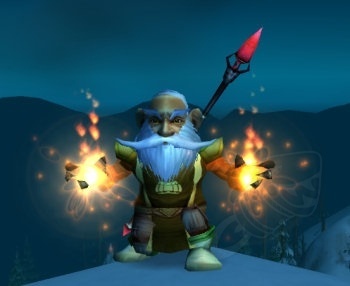
Welcome back, Warlocks.
I hope that the new year is finding you awash
in a sea of your enemies’ blood.
Last week we delved into the idea behind
Destruction with an overview of the basic concept behind the spec, now we will probe the essential spells and abilities of this
spec to prove that the Destruction warlock is one masochistic son of an ember.

Immolate: For the longest time, I misunderstood this word.
I often think of thought of it as
meaning what the graphics show me: the mob being wrapped in fire.
Dictionary.com tells us, though, that it means "to offer as a
sacrifice; to destroy by fire." By this definition, the warlock's target may be
engulfed by fire, but that’s not the
main purpose of the spell. The word sacrifice implies a state of helplessness
on the behalf of the sacrificed. Sacrifices are not typically done voluntarily
when violence is involved.
If the target
is helpless, and the player cast this spell, then logic dictates that the
entity in power is the player. This spell, though comes with a price (on the part of the engulfed) in that fire likes to use its fuel, and whenever a large deposit of fuel is found...
.
 |
| Boom. |
Conflagrate: A derivation of the noun
conflagration, this is the verb to show an
"extensive, destructive fire." While the
meaning and the mechanics differ, the end result is quite similar: an explosion of
fire. We can interpret this as either: A. The fire around the mob (that is currently
engulfed by immolate) explodes in a fireball centered on the mob OR pockets of
the mob’s body explode outward (or inward). I think I like the second option, since the
first seems like a flare-up, like a grease fire (ewww, the mob’s fat is
burning), whereas the second option brings to mind parts of the mob’s body
exploding like a water balloon filled with gasoline (gives a whole new meaning
to the body part termed the ‘bladder,’ eh?).

Chaos Bolt: At first glance, this
does not seem to fit within the theme of fire that has thus far pervaded the
spec. Chaos is a state of utter confusion or disorder; total lack of
organization or order. Fire is, by its nature, disorganized.
It follows no patterns, shows no restraints
that are not imposed upon it from the outside. The warlock’s power is drawn
from demonic forces, which, throughout multitudes of mythologies, represent the
opposite of order and control, either passively or actively. While it is not
fire, It does embody the heart of what destruction is: the opposite of
creation.
Next week, we'll wrap up the query into destruction and get ready to assault the
Faustian bargain.
 Welcome back, Warlocks. I hope that the new year is finding you awash
in a sea of your enemies’ blood. Last week we delved into the idea behind
Destruction with an overview of the basic concept behind the spec, now we will probe the essential spells and abilities of this
spec to prove that the Destruction warlock is one masochistic son of an ember.
Welcome back, Warlocks. I hope that the new year is finding you awash
in a sea of your enemies’ blood. Last week we delved into the idea behind
Destruction with an overview of the basic concept behind the spec, now we will probe the essential spells and abilities of this
spec to prove that the Destruction warlock is one masochistic son of an ember.
No comments:
Post a Comment